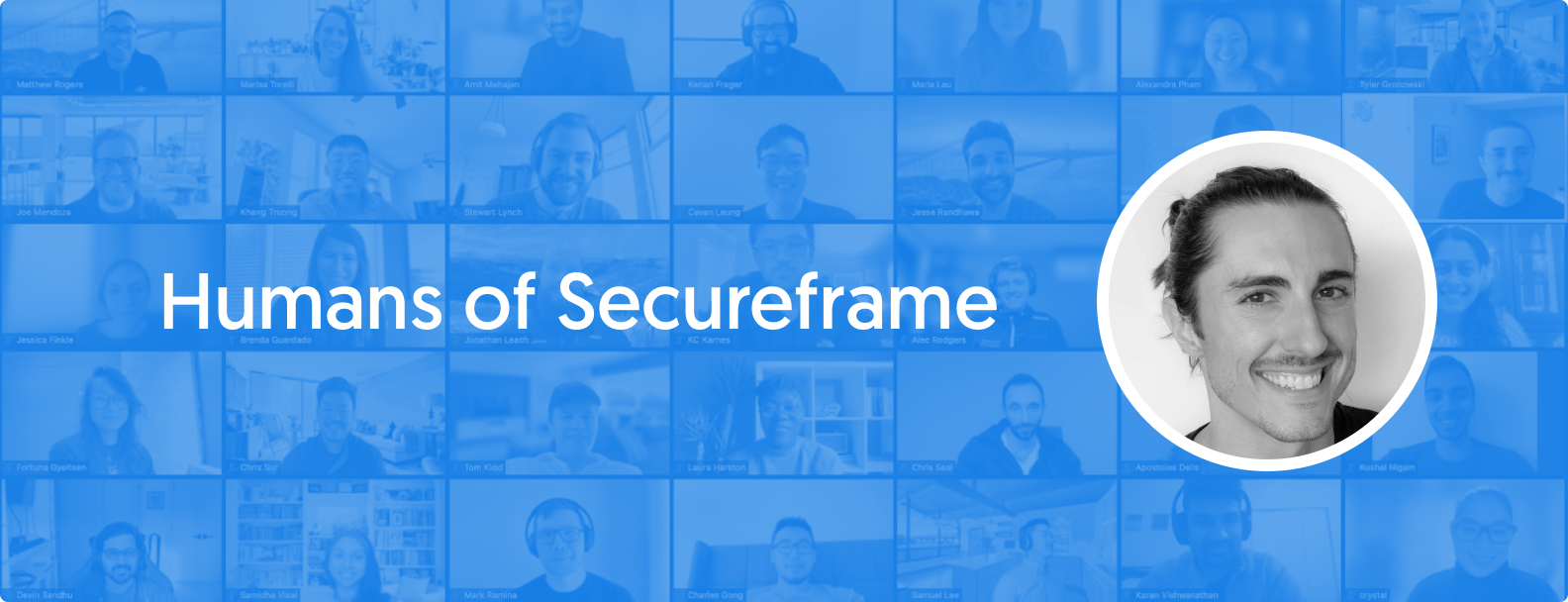
Humans of Secureframe: Product Design Lead Joe Winter on Building a Company-Wide Design Culture
Emily Bonnie
Senior Content Marketing Manager
Design is the intersection of people and technology. Done right, it can create clarity and empower users—making the most complex workflows feel like second nature.
Six months ago, I joined Secureframe as their first full-time product designer. At the time, I knew nothing about security and compliance. I was leading engagements at a product design and strategy consultancy in San Francisco, working across a wide variety of product domains with Silicon Valley startups and technology companies. I’ve worked on some complex products, but the particular problems Secureframe is solving got me hooked.
The best designers see complexity as an opportunity and are empowered by constraints. I joined Secureframe because the problem domain is a ball of wax to be untangled.
I quickly learned that not only are the product opportunities vast, the people are smart, dedicated, and innovative. Who wouldn’t jump at the opportunity?
The role of early-stage product designers
As a consultant, you’re selling the process as much as the deliverable. Design is often used to challenge assumptions and inspire action. Wireframes, prototypes, and research decks act as internal rallying cries to influence product strategy and align departments. When the project is done and the deliverables are sent, you can close your laptop and have a beer.
Working at a hyper-growth startup with proven market fit is a bit different.
Design is a tactical differentiator, critical for the success and ultimate survival of the product and business. As a design team of one, this can be a lot to shoulder. In the short time I’ve been here, I’ve learned the delicate balance between thinking both strategically and tactically—keeping an eye on the horizon while simultaneously laying the tracks. The beers I drink now are between iterations instead of clients.
Unlike agency work, my design influence is now more bottom-up than top-down: partnering with different departments, collaboratively unpacking problem spaces, and demonstrating the value of proper design thinking methodology. I’ve found that I now do a lot more listening than talking—showing, rather than telling. The output of these strong working relationships is not only good work, it’s fellow design advocates.
And design is never done. As one of my mentors put it, “You have to live with your decisions.”
As an early designer at a fast-growing company, I’ve learned that my primary job is to create the best possible solution with the limited information available. It won’t be perfect—and that’s ok. Our design solutions strive to solve complex problems in the most understandable and elegant way and are ever-evolving. Discover, define, develop, deliver—and do it again and again and again.

Building a strong design culture
When you work at a design studio, everyone knows the vernacular. Conceptual models, information architecture, affinity mapping, cognitive load, confirmation bias, and on and on. When you present a project, people know what to look at and what to ask.
Spending enough time in a design dojo like this can make you forget the world outside its walls. Once you’re deployed on a tour of duty in-house, you become an ambassador to the process and craft. It isn’t just making it pretty and it’s not all buttons and icons.
Since joining Secureframe, I’ve held Design Office Hours every week with an open invitation to anyone at the company. During these sessions, we talk about what design is, why it’s important, and how everyone at the company is connected to it.
Everyone from sales, customer success, engineering, marketing, and operations joins to chat in an informal, collaborative setting. We share projects in flight, teach collaborators how to give good feedback, and listen to what people are talking about with customers.
Creating transparency in our process strengthens the work output and connects design to every part of the business. It creates clarity in our process and craft. This is the design of design, and we’re just getting started.

What’s ahead for Secureframe Design
The best designers are curious, creative, and humble—but they are also bold. This is especially important at early-stage startups. True innovation comes from bold ideas, creating a wide variety of concepts, testing them, learning, and iterating.
But more importantly, true innovation comes from a diversity of perspectives.
I’m super excited to be building a design team that not only challenges assumptions but their own ways of thinking. A strong internal design culture of critique, empowerment, and growth radiates outwards to the company at large. The new designers who join will help our growing design practice continue to find its voice and brand in the company.
Secureframe Design is always pushing the envelope, harnessing complexity, and bringing creativity and elegance to a highly-technical domain. Sound interesting? Come join us!

Emily Bonnie
Senior Content Marketing Manager
Emily Bonnie is a seasoned digital marketing strategist with over ten years of experience creating content that attracts, engages, and converts for leading SaaS companies. At Secureframe, she helps demystify complex governance, risk, and compliance (GRC) topics, turning technical frameworks and regulations into accessible, actionable guidance. Her work aims to empower organizations of all sizes to strengthen their security posture, streamline compliance, and build lasting trust with customers.